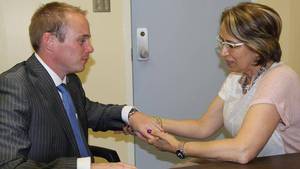Staying up-to-date on new treatments and procedures is an important task for healthcare professionals. Fortunately, the Interprofessional Practice and Learning (IPP & L) team at the QEII is on hand to help staff stay on top of their game.
Consisting of clinical leaders from many areas of care, the team brings their knowledge and expertise to healthcare practice and learning.
“We work with clinical and support teams throughout the QEII with the end goal of promoting quality of care for patients,” explains Cathy Ann Casault, director of NSHA’s Central Zone Interprofessional Practice and Learning team.
The education and training the team provides is hands-on, practical training, allowing clinical teams to learn through experience.
As a clinical nurse educator, Angeline Comeau monitors the learning needs of different departments based on patient care need trends.
“There’s so many things we do that will impact patient care,” says Angeline. “We do skills stations with new grads, assist with unit-based orientation for new staff, and have close relationships with managers of all the units. We’re able to shape how health professionals provide the best care for patients.”
Professional practice leader, Shawna Hudson, notes that the team takes lessons learned from particular areas of care or patient populations and looks for transferability to other areas of care. An example of this is early mobilization practices adopted in the QEII’s intensive care unit (ICU) having the potential to benefit other departments.
Early mobilization is an early movement/walking program for patients in ICU. Research indicates that early movement of ICU patients is important to enhance patient outcomes such as the prevention of muscle weakness from immobility. The practice could be applied to all inpatient units at the QEII, where patients may have traditionally been on bed rest.
The IPP & L team helped support the integration of early mobilization best practice into care delivery processes and the resources required, such as patient equipment and identification of staff champions to support successful implementation.
“We want every patient, no matter where they are cared for, to have the same high standard of care and the best outcome.”
-Cathy Ann Casault
“By helping the care teams move toward early mobilization and decreased length of stay, the team was able to help patient outcomes by keeping them stronger while in the hospital,” says Shawna.
Working in an academic health centre is another important aspect of the IPP & L team. With a wealth of resources at the QEII, Cathy Ann says the team is “constantly learning new things.”
Jane Allen, a learning and development consultant, adds that at the QEII they’re able to “draw on the skills and knowledge base of many healthcare professionals. This supports collaboration while maintaining standards and best practices for different professions.”
The work the IPP & L team is doing at the QEII is reaching beyond the health centre. Embedded in every patient population at the QEII, their work has been emulated across the province.
For physiotherapy professional practice coordinator, Andrea Goldstein, the job is incredibly fulfilling.
“I’m proud of the work I do. It’s really about how we support the QEII staff in providing the best patient-centred care and how we are collaborating as a team to get there.”
“The cross-section of talent, range of experience and cultures is woven into the delivery of the services we provide,” Cathy Ann concludes. “This enables our learning and our practice to be inclusive, caring and compassionate, resulting in quality, collaborative, person-centred care.”
“We want every patient, no matter where they are cared for, to have the same high standard of care and the best outcome.”








